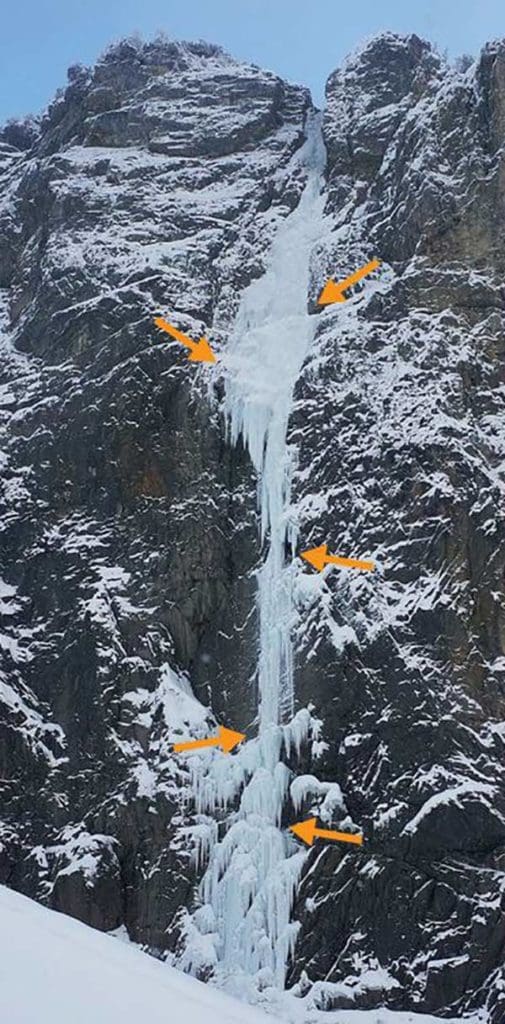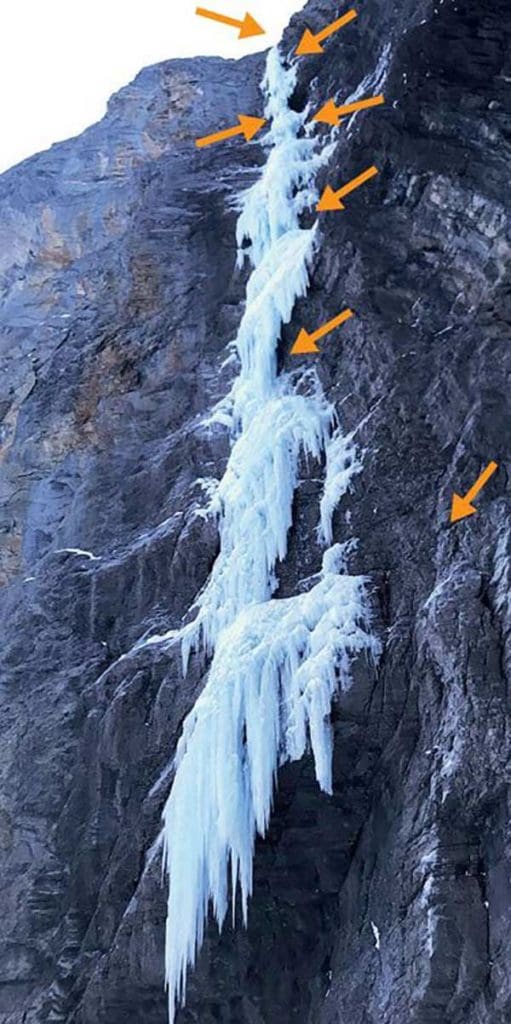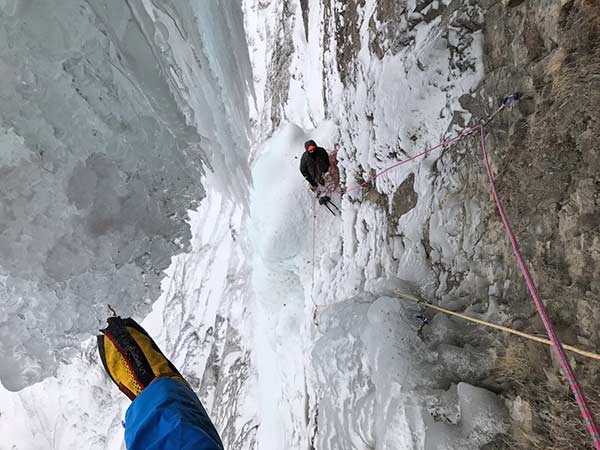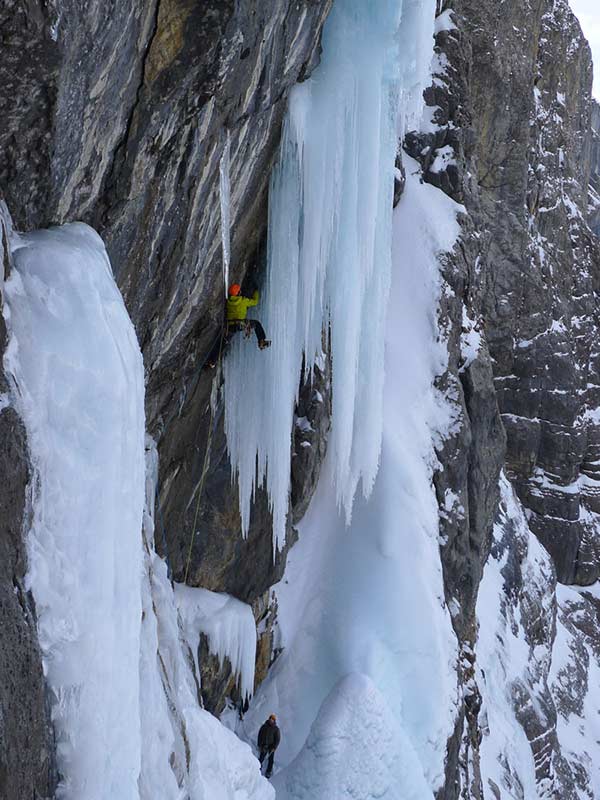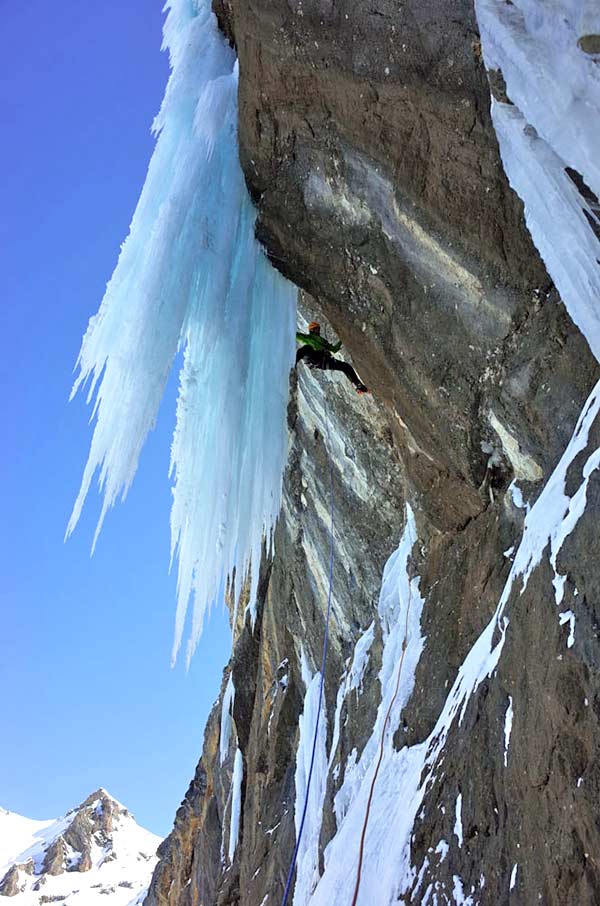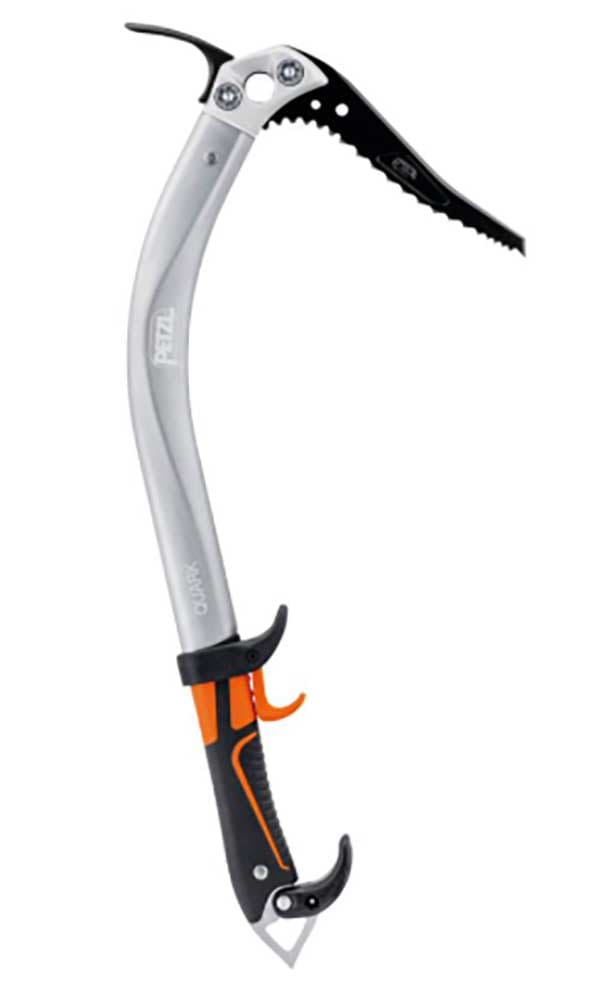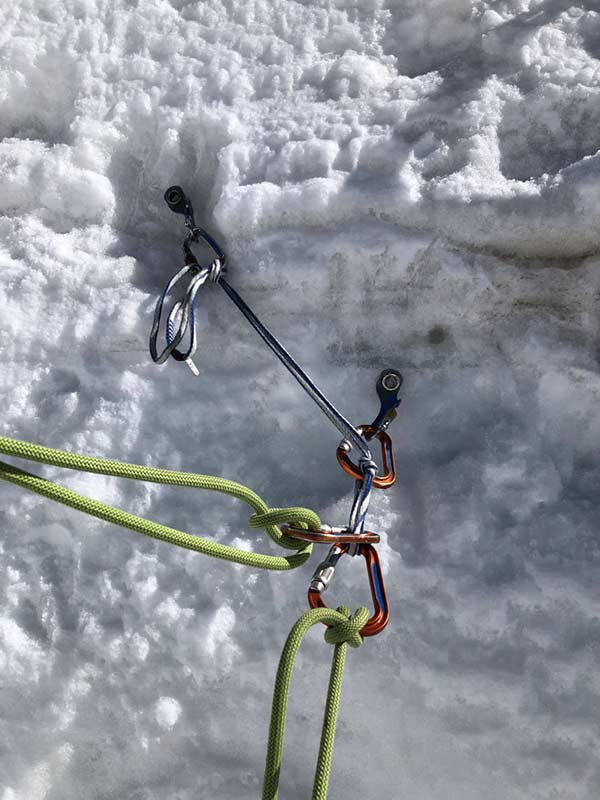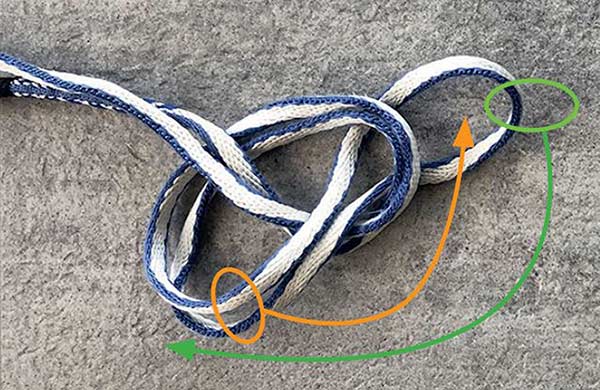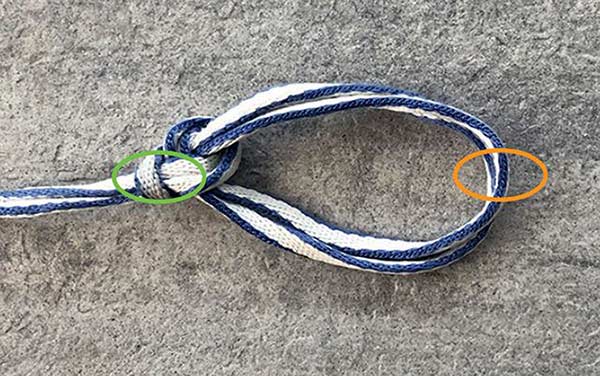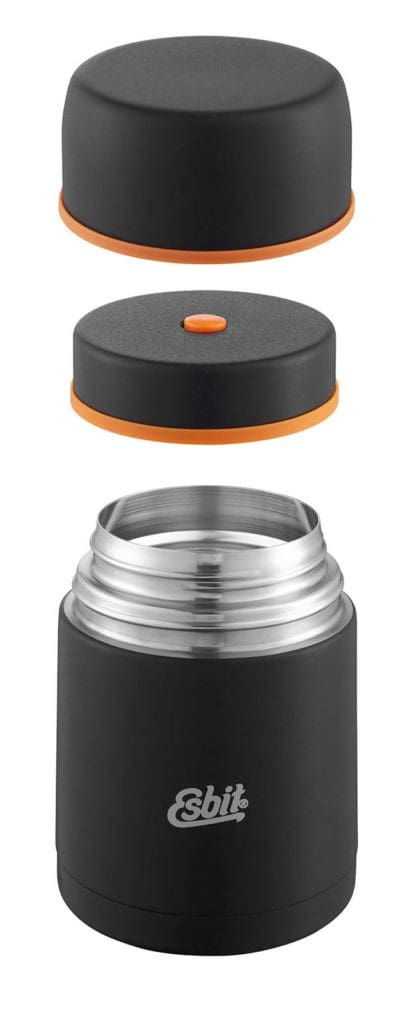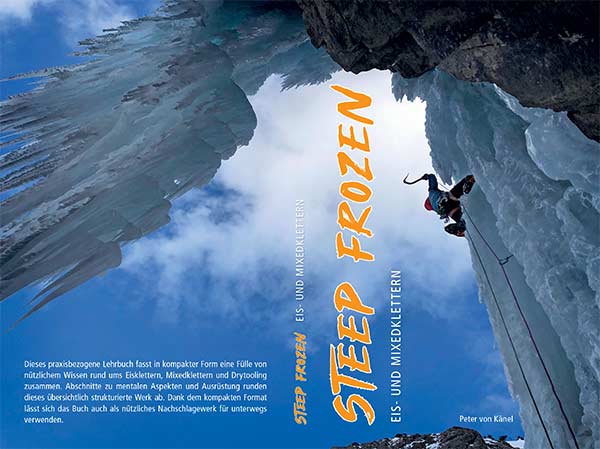Where and how to set up belays in multi-pitch ice climbing is highly safety-relevant. Building on the previous articles on assessing ice conditions and setting ice screws, ice climber, mountain guide and author Peter von Känel explains what is important when building belay stands in the ice.
A contribution by Peter von Känel - presented by Petzl, Bächli Bergsport and Esbit
You will learn that in this article
- Where do you stand when ice climbing?
- How do you build a stand in the ice?
- Which belay device is suitable for ice climbing?
- Belay to the body or the stand?
- Building a stand in the ice: tips & tricks
Where do you stand when ice climbing?
The choice of belay is of crucial importance for safety when ice climbing. Safety comes before convenience. A pitch must meet the following criteria – in this order:
| Criterion | importance |
|---|---|
| The stand is protected from falling ice. This is either when it is outside the icefall delta or when it is in an ice cave. | Mandatory |
| Solid securing points are available or easy to attach yourself. | Mandatory |
| You are protected from the wet at the stand. | Very important |
| The belay allows communication between the rope partners. | Important |
| The stand is comfortable. | Desirable |
Choosing the location of the stand in the ice
The following series of images illustrates the topic using various examples:
«In less steep terrain, you don't always find a sheltered stand. In such cases it is important that the person leading climbs with at least enough offset so that the belayer is always outside the ice fall delta.”
Petzl Quark: The ice tool for ice climbing
The Quark is a versatile ice tool designed for technical mountaineering and ice climbing. Its perfectly balanced design and ice pick ensure secure placement in any ice.
The Trigrest and Griprest finger rests enable easy and comfortable handling in every situation. They improve grip security in difficult passages.
The Quark modular ice ax easily adapts to different and technically demanding routes: snow couloirs, ice gullies, north faces, ice falls, etc.
The magic word here is Petzl Alpen Adapt. This modular system for ice axes and crampons makes it possible to easily swap out the various components and adapt them to personal needs.
How do you build a stand in the ice?
A permanently stressed ice screw can melt out over time. Warm ice temperatures and solar radiation accelerate this process. When standing in the ice, one ice screw should always be unloaded.
In practice, a series connection of two ice screws of at least 13 cm length has proven itself for multi-pitch ice climbing, whereby the lower ice screw with the central point bears the entire load and the upper ice screw serves as unloaded reinsurance. Both ice screws are set at least 30 cm apart in compact, well-bonded ice.
The “soft eye” is a suitable central point. To do this, tie a double bulin into a sling. This is clipped into the screw carabiner of the lower ice screw as the central point. Now connect the carabiner of the upper ice screw to the sling using a pole throw and clip the end of the sling into the same carabiner. The sling length to the upper ice screw is chosen so that the sling is stretched but not under load.
«Rope teams often use the screw carabiner of the lower ice screw directly as the central point. This method has the following disadvantage, especially when securing a position: If the person climbing the ladder falls, the central point can be thrown violently upwards. If the central carabiner and the ice screw jam, this could in extreme cases lead to material breakage. With the "soft eye" this risk is significantly smaller.
As an alternative to the «soft eye», you can use the following method, for example: Fix the sling directly to the flap of the lower ice screw with an anchor stitch. Now fix the central carabiner close to the lower ice screw with an anchor stitch. The webbing sling is then fixed in the carabiner of the upper ice screw using a pole throw so that it is stretched but not under load.
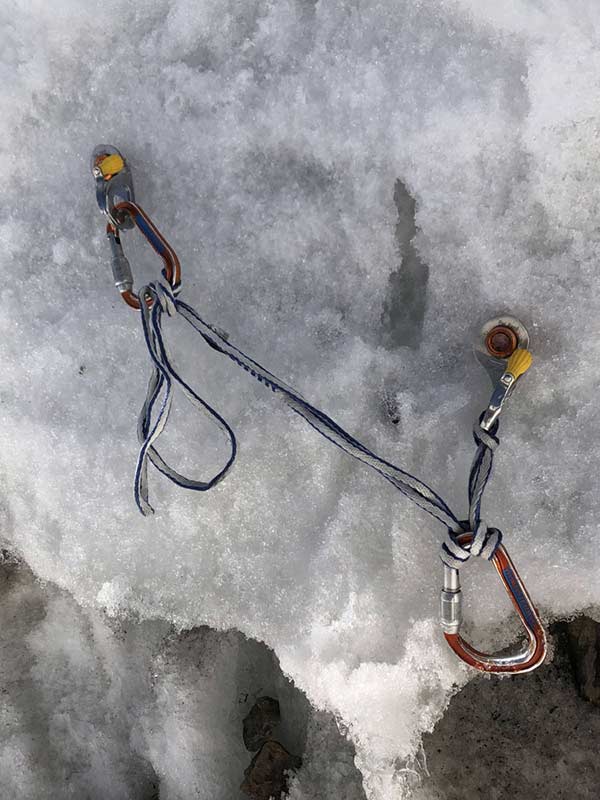
Warmth in icy environment: Thermal container from Esbit
Whether still during the tour at the belay station or at the foot of the ice fall: when the body calls for new energy, a hot meal is just what you need.
Perfect if you have already prepared them at home and taken them with you in the double-walled stainless steel thermal container.
Esbit's food jugs keep food warm or cold for up to 24 hours, although the latter property is probably less important when ice climbing.
The wide opening allows easy filling and cleaning. The closure is absolutely tight and has a pressure release button. The lid can also be used as a bowl if required.
In addition to thermal containers, the Sculptor range also includes vacuum flasks, thermal mugs and drinking bottles.
Which belay device is suitable for ice climbing?
HMS and tubers are used in multi-pitch ice climbing. Automatic circuit breakers such as Grigri are unsuitable. If the ropes are iced up, often only the HMS works. Therefore, you have to master it before you venture into a multi-pitch ice climbing tour.
In addition to the advantages of high braking efficiency and ease of use, the HMS also has certain limitations. For example, you should not use a half-rope technique when belaying a lead climb, as the unloaded rope can be damaged in the event of a fall due to the friction in the HMS knot.
Speaking of falling: When ice climbing, falls in the lead – unlike in sport climbing, for example – should be avoided as much as possible due to the risk of injury. It makes perfect sense to check out and expand your own limits, but you should practice it top-rope.
"A low-friction rope course can also be achieved without half-rope technology using extendable quickdraws."
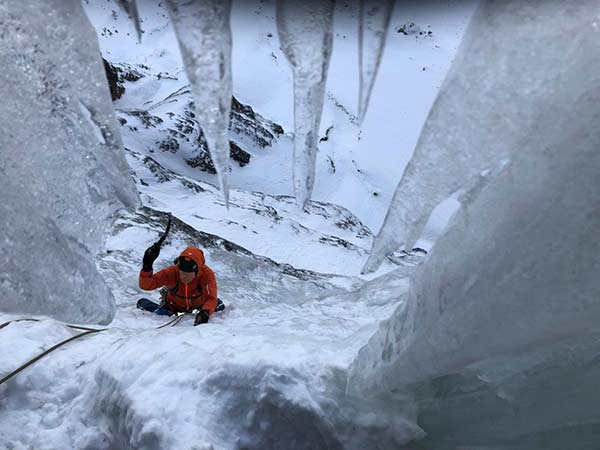
Belay to the body or to the stand?
When seconding, always belay to the belay. When leading, you can use one of the techniques listed below depending on the situation.
- Backup with HMS to the status:
In the event of a fall, the sudden pull is absorbed by the belay and can be easily controlled by the belayer. The method is uncomplicated and is therefore particularly suitable for belayers with little experience. As mentioned above, you should avoid the half-rope technique with this method. This increases the impact force in the event of a fall and thus the load on both the ice screw and the person climbing. As we im last article However, as you have seen, a correctly set ice screw has enough holding power to absorb such an impact force. The disadvantage of increased rope friction can be reduced by using extendable quickdraws. - Securing with Tuber on the stand:
Setting it up correctly is a bit more cumbersome. The method is suitable for complex rope routes and potentially long falls. - Securing with Tuber on the body:
It is important to be aware that the braking effect of a tuber is relatively small and that the sudden pull of a fall can throw the belayer off balance. Both factors reduce fault tolerance. Therefore, this method should only be considered by experienced rope teams and for climbing rope lengths that can be secured well (no very long falls possible).
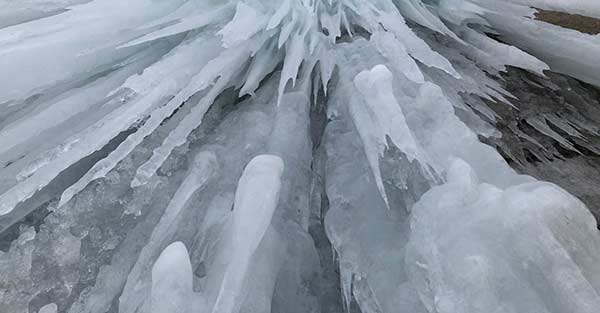
Building a stand in the ice: tips and tricks
- With both the “soft eye” method and the alternative method, a well-established rope team with good communication can gain time in multi-pitch ice climbing: as soon as you have set the lower ice screw and fixed yourself in the central point, the person on the lower stand can already do it remove their upper ice screw.
- For a belay that is loaded for a longer period of time, for example for top rope climbing, three ice screws are usually used. Two ice screws are connected using compensation anchors, which share the load. The third ice screw is connected in series, it serves as an unencumbered reinsurance. A good alternative to this is an ice hourglass, plus an unencumbered ice screw for reassurance.
- Before any manipulation, especially unhooking a rope or carabiner, consider briefly whether this is correct. In order to maintain an overview, it has proven useful to consistently remove everything from the stand that is not in use.
To the author
Peter von Känel, born in 1973, is a mountain guide, aviation engineer and passionate climber. For many years, Peter has been intensively involved not only with ice and mixed climbing, but also with the human factor.
In addition to some sensational ice and mixed first ascents such as the BASE route in the Lauterbrunnen Valley, Peter has repeated many extremely demanding routes, sometimes as a mountain guide.
With these tours, as well as in many discussions with experienced climbing colleagues, Peter has acquired a wealth of knowledge about ice and mixed climbing over the years. He passes on this knowledge in courses, coaching and with his new textbook.
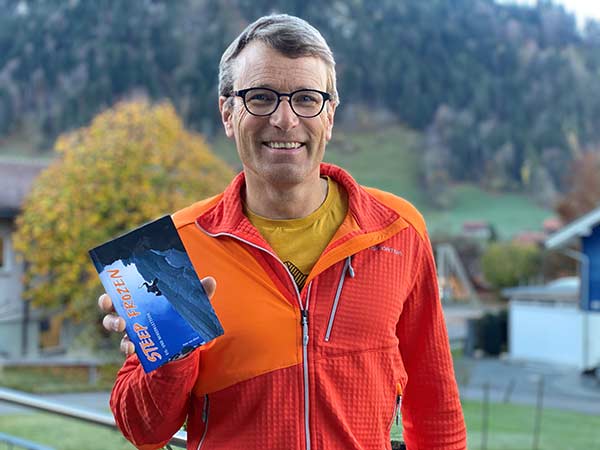
Steep Frozen: A Practical Textbook
This ice cream series only scratches the surface of this fascinating topic. For all those who want to know more about it, the beginning of November 2022 is the book Steep Frozen appeared.
This practical textbook by Peter von Känel summarizes a wealth of useful knowledge about ice climbing, mixed climbing and dry tooling in a compact form.
Sections on mental aspects and equipment complete this clearly structured work. Thanks to its compact format, the book can also be used as a useful reference book for on the go.
The book is in Filidor publishing house published and costs CHF 32.00. You can find more information, including extracts and reader feedback, at Peter von Känel's Website.
That might interest you
- Ice climbing pro tips: Assess ice conditions and assess them on site
- Ice climbing: What to consider when getting started & tips from professionals
- All hooks flexed away: What next in the conflict over the Battert climbing area?
Do you like our climbing magazine? When we launched LACRUX, we decided not to introduce a payment barrier. It will stay that way, because we want to provide as many like-minded people with news from the climbing scene.
In order to be more independent of advertising revenue in the future and to provide you with even more and better content, we need your support.
Therefore: Help and support our magazine with a small contribution. Naturally you benefit multiple times. How? You will find out here.
+ + +
Credits: Cover picture Peter von Känel


